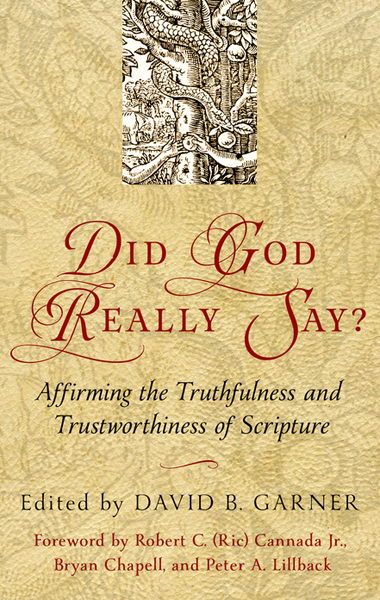
I just put down Robert Letham’s The Holy Trinity, and while I thoroughly enjoyed it and recommend it as an introduction to the history and development of the doctrine, there is one gripe I can’t seem to lay down. Throughout the nearly five hundred pages of discussion, he faults theologians for using trinitarian analogies[1] that trend toward some form of heresy—usually modalism, tritheism, or subordinationism. Augustine’s psychological analogies, Multmann’s society of persons, and Irenaeus’ portrayal of the creator and his two hands (the Son and Spirit) fit into these categories respectively. Before I get into why this bothered me, let me preface the grievance with a memory.
Years ago at one of Westminster’s Preaching Conferences, I sat in the dim auditorium and listened to Carl Trueman speak about how there are few, if any, adequate analogies for the Trinity, because nearly every one of them inevitably leads to heresy. Ice, water, and steam? That’s modalism. Three human persons from the same family? That’s tritheism. A father and his two sons? That’s subordinationism, or Arianism—take your pick depending on the severity. Even analogies that seem to elude heresy lead us in unbiblical directions. The analogy of a fire, its light, and its heat brings to mind an impersonal deity, not the tripersonal God of Scripture.
So, we leave trinitarian analogies by the wayside, right? Not quite. Trueman’s comment and some of Letham’s have led me to revisit remnants of the Trinity in the world around us, what Augustine called vestigia trinitatis, “vestiges of the Trinity.”[2] He dedicated most of De Trinitate to surmising God’s trinitarian imprints on man’s nature.[3] Most of Augustine’s analogies are referred to as “psychological,” meaning that they highlight trinitarian structures in a person’s internal configuration (e.g., being, knowledge, and will). Because of this, Letham suggests that Augustine’s psychological analogies may trend toward modalism; by foregrounding the unity (being, knowledge, and will are rooted in one person, not three), they downplay plurality, and at least flirt with Sabellian heresy. Is he right? Was Trueman’s rant apropos for orthodox trinitarian theology?
In one sense, yes—to both men. Letham is correct in observing that Augustine’s analogies can be misread as trending toward modalism, and Multmann’s seem to move toward tritheistic territory. But the reason why such analogies gravitate in these directions is not because they are, strictly speaking, defective. After all, when pressed, every trinitarian analogy certainly does lead in one of these directions by default, because every analogy is defective—that’s what makes it an analogy! Linguistically speaking, we cannot ever expect exact correspondence between an analogy and its referent. If there were exact correspondence, we would have a definition, not an analogy. When it comes to the Trinity, we tend to forget that an analogy is an “aptness of proportion” or a “resemblance of relations,” not an identity of relations.[4] The goal of an analogy is to draw out similarities between it and its referent in illuminating ways, not to define the referent itself. We have the creeds for just that reason. So, while Letham might be correct (and some scholars suggest that he is operating with a stale understanding of Augustine’s psychological analogies), he would have been fairer to Augustine if he had taken to heart the latter’s own caveat: trinitarian analogies were in reference to “disparate images,” and not meant to refer with theological acuity to the Father, Son, and Holy Spirit.[5] Augustine would affirm that analogies are analogies—wonderfully helpful when understood for what they are, terribly dangerous when mistaken for what they are not.
Trueman, for his part, is also correct. At least, there are no properly “adequate” extra-biblical analogies for the Trinity—analogies that, when pressed, do not lead to heresy. But why is that? Well, we invariably encounter paradox and incongruity when trying to form an analogy from this world for the God who made it. A Trinitarian analogy is the functional equivalent of trying to explain the light of the sun with a candle. The sun is what allows the candle (both in its material composition and in our vision of it) to exist in the first place; it gives light only because the sun exists and creates its elemental environment. By its very definition the candle is contingent and dependent on the sun, and so pales in comparison. If we try to move from the candle to the sun, we are immediately frustrated by the candle’s limitation and inadequacy—its utter inability to mirror the aspects of the sun’s light and heat. Its features and relations simply cannot correspond sufficiently to those of the sun. Something similar might be said of our earthly analogies for the Trinity, because it is the self-contained ontological Trinity that grounds everything earthly. No analogy, then, will be adequate because we are moving from what is ens ab alio to what is ens a se.
Nevertheless, this does not mean that analogies for the Trinity are unhelpful and inappropriate. We simply need to realize the limitations outlined above. In short, we must not press analogies. Instead, if we constantly remind ourselves, even in hyper-vigilance, that pressing any trinitarian analogy will lead to some form of heresy, then we can be faithful to the revelation of Scripture as we explore the depth and breadth of God’s trinitarian lordship over all of creation.
I would be the first to recognize the inadequacy of language when it comes to penetrating the mystery of the Trinity. Yet, I would also be the first to affirm that language—communicative behavior—is rooted in the Trinity.[6] If God by nature is a tripersonal, communicating being, then we must look for ways in which we can use our image-bearing communication to illumine the truth of his triune lordship over every fiber of creation. So, when it comes to trinitarian analogies, words, like old friends, always have a place at the table. We just have to mind the manner in which we use them, and understand that our referent is beyond comparison. That does not necessitate silence; it simply demands we keep chary in light of the challenges.
[1] By “Trinitarian analogies” I mean analogies from our experience that serve to illuminate how the three persons of the Godhead are distinct and yet inseparable.
[2] Augustine, De Trinitate 12.2.6–8.
[3]“It was especially Augustine . . . who in various ways and perspectives found the clear imprints of the Trinity in human consciousness and reason.” Later in the church, this developed into the so-called psychological and sociological analogies, but it was the former that held Augustine’s attention. Within man’s consciousness, he found traces of God’s triunity in “the trinity of being, knowing, and willing; essence, knowledge, and love; [and] mind, knowledge, and love.” Bavinck, God and Creation, 325.
[4] James A. H. Murray et al., eds., The Oxford English Dictionary (2d ed.; New York: Oxford, 1989), 1:432.
[5] Augustine, De Trinitate 9.1.
[6] Here I side with Kenneth Pike: “Language is behavior, i.e., a phase of human activity which must not be treated in essence as structurally divorced from the structure of nonverbal human activity. The activity of man constitutes a structural whole, in such a way that it cannot be subdivided into neat ‘parts’ or ‘levels’ or ‘compartments’ with language in a behavioral compartment insulated in character, content, and organization from other behavior. Verbal and nonverbal activity is a unified whole, and theory and methodology should be organized or created to treat it as such.” Language in Relation to a Unified Theory of the Structure of Human Behavior (2d ed.; Paris: Mouton, 1967), 26. See also Vern S. Poythress, In the Beginning Was the Word: Language—A God-Centered Approach (Wheaton, Ill.: Crossway, 2009), 18.
Pierce T. Hibbs (MAR) serves as the Assistant Director of the Center for Theological Writing at Westminster Theological Seminary. He is currently enrolled in the Th.M. program and studying the language theory of Kenneth L. Pike. Pierce, his wife, Christina, and their son, Isaac, reside in Telford, PA.

The Alliance of Confessing Evangelicals is member supported and operates only by your faithful support. Thank you.















 © Alliance of Confessing Evangelicals
© Alliance of Confessing Evangelicals


